Since the end of August visitors to the permanent exhibition have been able to purchase small artworks from an ‘art vending machine.’ The artworks have been created by Jewish artists living and working in Berlin.
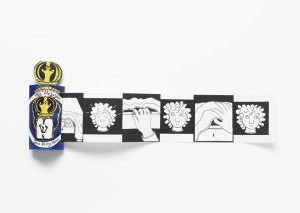
Paper mezuzah with pull-out comic strip by Zara Verity Morris
© Jewish Museum Berlin, photo: Jens Ziehe
Today we present one of the artists: Zara Verity Morris from London. Morris is currently studying for her Masters degree at the “Institute for Art in Context,” at the Berlin University of the Arts. For the art vending machine she has created a comic strip called “The Mezuzah” on a pull-out paper scroll. (A mezuzah is a small case, which is attached to the door posts of Jewish households. Inside is a handwritten parchment scroll with the Hebrew prayer “Shema Yisrael” (“Hear O Israel”).
Christiane Bauer: Zara, can you for starters briefly explain to me why you produced this particular object for the art vending machine?
Zara Verity Morris: I found it an interesting challenge to play with the limited space of the art vending machine, and wanted to make something that could be unfolded once it has been taken out. The long paper roll was inspired by the formal connection between the Torah and a mezuzah.
When I was a young child, I found a few mezuzot in a drawer in varying conditions. A few had open cases. I was surprised to discover a paper scroll lying inside one of them with Hebrew writing on it. I was excited, and thought it was like a toy Torah. As a child, one of my favourite parts of being at a service at synagogue was the heavy Torah being ‘undressed’ by two people; getting its velvet cover and decorations taken off to reveal the plain paper scroll underneath. I decided to turn these childhood memories into a comic.
How does “The Mezuzah” fit into your previous work?
I hadn’t really made any work that deals with Judaism until now, although ten years ago I did think about learning Hebrew intensively, which inspired an audio artwork called “Breakthrough Language.” The piece is made up of many different snatches of conversation in different languages, which are layered on top of one another. The resulting babble makes me think of visiting synagogue, as I don’t always understand everything, as my Hebrew is quite lacking. Being a non-native speaker in Germany can also sometimes feel the same.
When it came to making “The Mezuzah” I just did what I like doing – I draw a lot and I also paint comics scenes for myself at home. But this was the first time that I had ever created a comic as a work of art.
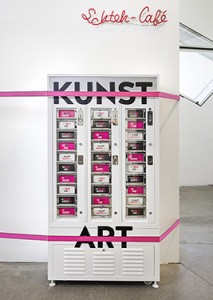
‘Art vending machine’ after the design by Hanno Dannenfeldt
© Jewish Museum Berlin, photo: Stephan Klonk
What appealed to you about the art vending machine project?
The fact that many people will be able to see my work is very appealing to me. I’d seen art vending machines before in England. It’s a fun way to acquire a piece of art. It is also a pleasure to create an artwork for a place that I like and often visit.
Does any particular artist inspire you in your work?
Recently I’ve been reading a lot of comics and graphic novels, above all the work of Joann Sfar (Klezmer Book One: Tales of the Wild East; The Rabbi’s Cat) and also Sarah Glidden (How to Understand Israel in 60 Days or Less). I like the fact that Joann’s drawings don’t look perfect. Painting is like playing an instrument; you have to practice a lot if you want to be any good. I like that Joann’s style is so loose – it looks so effortless.
What issues are important to you in your work?
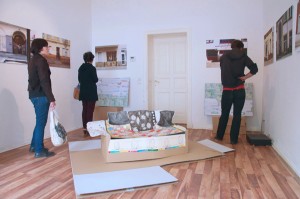
The exhibition “ja, ich wohne hier” (“yes, I live here”). Pop-up book by Zara Verity Morris
Photo: Robert Stokowy
That’s a good question. The project has led me to start asking “what does it mean to be a ‘Jewish artist’?” and “how has Judaism shaped who I am?” Yet I am also interested in engaging with my immediate surroundings. Many of my recent projects have been related in some way to Neukölln (a district of Berlin), because that’s where I live. In the last couple of years I have carried out two large projects for the arts festival “48 Stunden Neukölln” (“48 Hour Neukölln”). Last year I made an audio guide, and this year a pop-up book featuring scenes of apartments in the area. One aspect of my life is “I now live here in Neukölln,” and another is “I’m Jewish.”
What were the decisive factors that led you to move to Berlin?
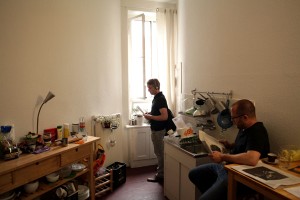
“Das Eckgebäude” (“The Corner Building”). An audio-guide about an apartment building in Neukölln by Zara Verity Morris
Photo: Alexander Veselak
An artist needs an environment where s/he doesn’t have to work forty hours a week just to pay the rent. I’m from London and it’s difficult to get along there. I have more options here in Berlin. It’s great that there’s so much going on in Berlin. There’s so much art and culture, and it’s so diverse – from the classic museums to say self-organised, non-commercial performance spaces.
Is there also a Jewish scene within the arts scene?
Hmm, I don’t know. I do know a lot of Jewish artists, but it was only through this project that I learned several of them are Jewish. I never knew that beforehand. You could say, there’s now a Jewish scene at our institute [laughs].
Thank you for the interview, Zara! What response are you hoping for, when our visitors pull your artwork out of the vending machine?
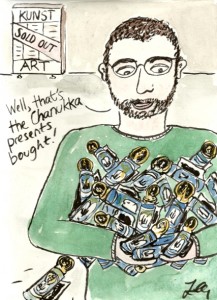
I don’t know if this link will work but here is a photo my friend Debbie the rabbi just posted on facebook of the dressed-up torahs being taken out in a fire drill.
http://www.facebook.com/photo.php?fbid=528761977205519&set=a.101512936597094.3010.100898969991824&type=1
They explain in the text below the photo why it is important to try and save Torahs if possible, but why our lives and safety are most important.